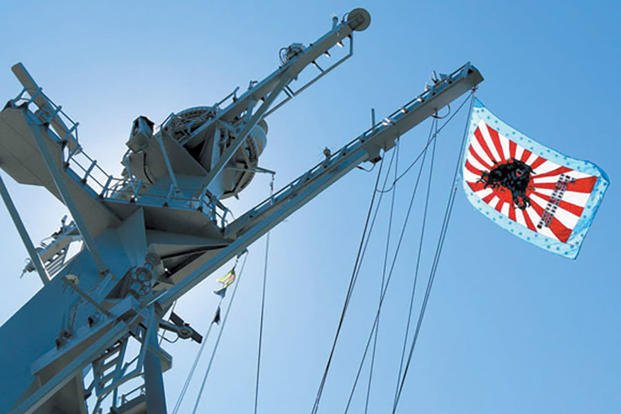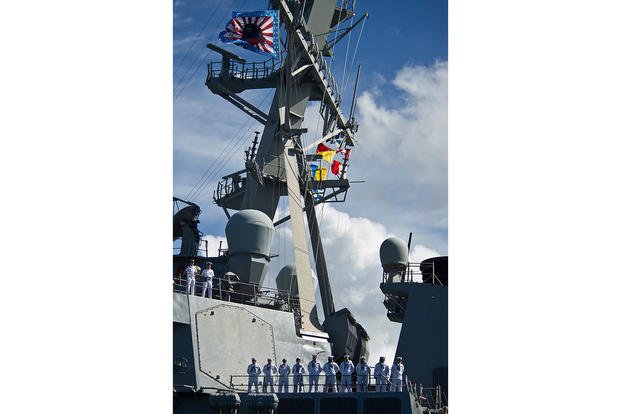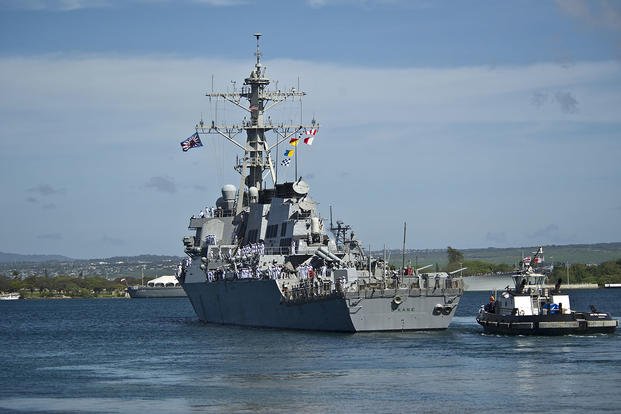U.S. Navy warships fly battle flags for many reasons, most often when they're entering or exiting their home port or during a training exercise at sea. Usually, battle flags are designed to pay tribute to a ship's namesake or particular history, like the USS Kidd's Jolly Roger or the USS Daniel Inouye's "Go for Broke" banner; sometimes, they're explicitly designed simply to look "badass." And sometimes, on rare occasions, a battle flag can do both.
For such a case, look no further than the USS O'Kane, which was most recently spotted flying its distinctive battle flag while steaming into San Diego in December.
Commissioned in 1998, the Arleigh Burke-class guided missile destroyer was named for Rear Adm. Richard O'Kane, who received the Medal of Honor for commanding the Balao-class submarine USS Tang against Japanese navy in the Pacific during World War II to the most successful record of any Navy submarine in history, sinking 33 enemy vessels in its short time in service.
In honor of its namesake, the O'Kane doesn't just fly any old battle flag, but a replica of the "Battle Cat" war flag that the Tang flew during its successful wartime patrols, complete with victory markings commemorating those 33 kills against Japanese vessels that Rear Adm. O'Kane racked up during the conflict.

The flag shows a black "battle cat" bursting from the middle of a rising sun, with the whole pattern trampled with victory markings. According to the Naval History and Heritage Command, the "rising sun" markings represent kills against warships, while the "meatball" markings represent kills against merchant vessels.
It's unclear how long after the O'Kane commissioning that the crew adopted the Tang battle flag as its own. Based on photos in the Defense Visual Information Distribution Service (DVIDS), the version of the battle flag that the O'Kane has flown in the past includes a blue border of stars surrounding cat-and-sun imagery. The version flown in December, however, appears to have forsaken the blue border.

While the Tang holds the honor of deadliest submarine in Navy history, it also holds the dubious distinction as one of the only known submarines to sink itself with its own torpedo during an engagement with Japanese vessels in October 1944, resulting in the loss of 78 sailors. Nine survivors, including O'Kane, were scooped out of the water by a Japanese frigate and relegated to a prison camp until the end of the war. O'Kane would receive the Medal of Honor for his actions during the Tang's final engagement.
"With ships bearing down from all sides, he charged the enemy at high speed, exploding the tanker in a burst of flame, smashing the transport dead in the water, and blasting the destroyer with a mighty roar which rocked the Tang from stem to stern," according to O'Kane's Medal of Honor citation. "Expending his last two torpedoes into the remnants of a once powerful convoy before his own ship went down, Comdr. O'Kane, aided by his gallant command, achieved an illustrious record of heroism in combat, enhancing the finest traditions of the U.S. Naval Service."
While the USS O'Kane deigns to commemorate the legacy and heritage of the Tang through its battle flag at least, it won't be the only vessel in the Navy's fleet to do so: General Dynamics subsidiary Electric Boat held a keel-laying ceremony for the future nuclear-powered, Virginia-class submarine Tang this past August. It's unclear when the new Tang might enter service.
Want to Know More About the Military?
Be sure to get the latest news about the U.S. military, as well as critical info about how to join and all the benefits of service. Subscribe to Military.com and receive customized updates delivered straight to your inbox.










